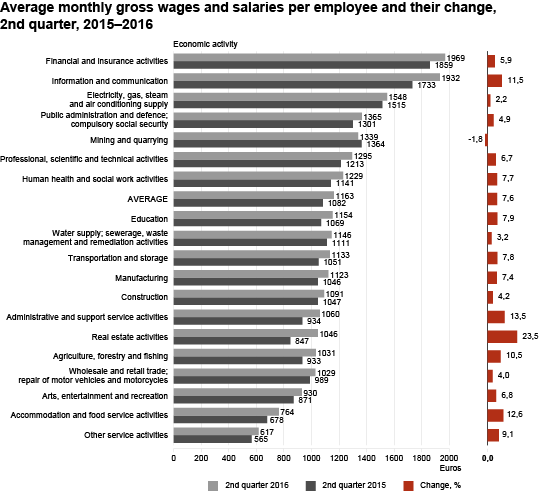In the 2nd quarter, the rise in average monthly gross wages and salaries decelerated
The average monthly gross wages and salaries were 1,141 euros in April, 1,129 euros in May and 1,220 euros in June. Higher monthly gross wages and salaries in June were mainly due to an increase in irregular bonuses and premiums and holiday leave pay.
Irregular bonuses and premiums decreased 8.3% per employee compared to the 1st quarter of 2016 but increased 15.6% per employee compared to the 2nd quarter of 2015. Irregular bonuses and premiums affected the increase in average gross monthly wages and salaries by 0.3 percentage points. Without irregular bonuses and premiums, the average monthly gross wages and salaries increased year-over-year by 7.3% in the 2nd quarter, with annual growth remaining on the same level as in the 1st quarter (7.2%).
Real wages, which take into account the influence of the change in the consumer price index, increased faster (8.3%) than the average monthly gross wages and salaries in the 2nd quarter of 2016 compared to the 2nd quarter of 2015 due to the continued decrease in consumer prices. Compared to the same quarter of the previous year, real wages have been increasing since the second half of 2011.
The average monthly gross wages and salaries were the highest in information and communication and financial and insurance activities. Compared to the 2nd quarter of 2015, the average gross monthly and hourly wages and salaries increased in almost all economic activities (except mining and quarrying). The largest increase of monthly and hourly wages and salaries occurred in real estate activities (23.5%). A higher than average annual growth was also recorded in administrative and support service activities (13.5%), accommodation and food service activities (12.6) and in information and communication (11.5%). The annual growth of monthly gross wages and salaries was the fastest in the Estonian private sector (9.4%) and the lowest in state institutions (5.5%).
In the 2nd quarter of 2016, by county, the average monthly gross wages and salaries were the highest in Harju, Tartu, Viljandi and Lääne counties and the lowest in Põlva, Ida-Viru and Valga counties. The annual growth of average monthly gross wages and salaries was the fastest in Tartu and Pärnu counties and the slowest in Ida-Viru county.
According to the Wages and Salaries Statistics Survey, the number of employees converted to full-time units decreased by 1.8% compared to the 1st quarter of 2016 and by 1.5% compared to the 2nd quarter of 2015. The bigger than average year-over-year decrease in the number of employees in full-time units occurred in mining and quarrying and in other service activities, while the largest year-over-year increase occurred in financial and insurance activities and in professional, scientific and technical activities.
In the 2nd quarter of 2016, the average monthly labour costs per employee were 1,568 euros and the hourly labour costs were 10.32 euros. Compared to the 2nd quarter of 2015, the average monthly labour costs per employee increased 7.5%.
Average monthly labour costs per employee and monthly gross wages and salaries and net wages and salaries, 1st quarter 2014 – 2nd quarter 2016 (euros)
| Year | Quarter | Average monthly labour costs per employee | Average monthly gross wages and salaries | Average monthly net wages and salaries |
|---|---|---|---|---|
| 2014 | I | 1 305 | 966 | 769 |
| II | 1 379 | 1 023 | 812 | |
| III | 1 319 | 977 | 777 | |
| IV | 1 404 | 1 039 | 827 | |
| 2015 | I | 1 361 | 1 010 | 815 |
| II | 1 459 | 1 082 | 871 | |
| III | 1 408 | 1 045 | 842 | |
| IV | 1 492 | 1 105 | 891 | |
| 2016 | I | 1 476 | 1 091 | 882 |
| II | 1 568 | 1 163 | 937 |
Statistics Estonia conducts the Wages and Salaries Statistics Survey on the basis of an international methodology since 1992. In 2016, the sample includes 12,350 enterprises, institutions and organisations. The average monthly gross wages and salaries have been given in full-time units to enable a comparison of different wages and salaries, irrespective of the length of working time. Calculations of the monthly gross wages and salaries are based on payments for time actually worked and remuneration for time not worked. The hourly gross wages and salaries do not include remuneration for time not worked (holiday leave pay, benefits, etc.). In short-term statistics, the average gross wages and salaries are measured as a component of labour costs. Labour costs include gross wages and salaries, employer’s contributions and employer’s imputed social contributions to employees.
